#orb weaver eggs
Text
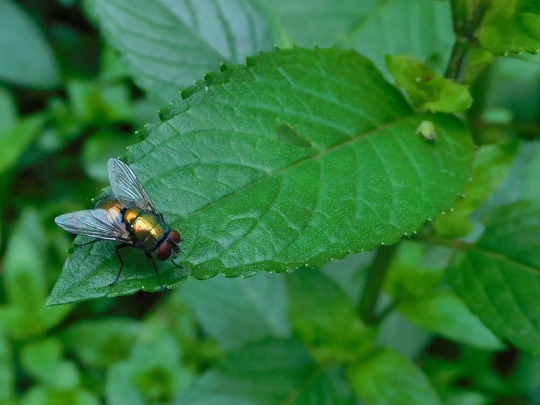



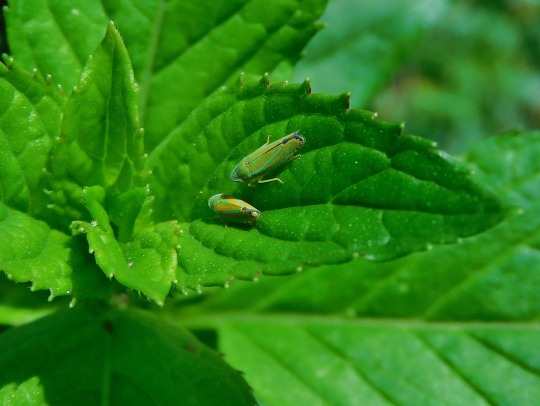
Some bug/insects/arachnids and or eggs...
#nature#bottle fly#american giant millipede#orb weaver eggs#harvestman#leafhopper#wildlife photography#backyard nature#nature photography
2 notes
·
View notes
Text

She is glowing!
(Gravid spotted orb-weaver / Neoscona sp.)
#spiders#spider#orb weavers#spotted orb weavers#Araneidae#my photos#hasn’t moved from this cluster of leaves in days so I’m assuming I was right about the eggs lol
19 notes
·
View notes
Text
developing a special interest on spiders might legitimately be one of the best things that has happened in my life i'm so serious not a single easier way to feel joy than finding one in any random place i'm in because there is literally always a spider somewhere in some corner that you can find
#bored in class? i simply look to the corner of my classroom and find like 3 cellar spiders#bored at a family gathering? my mom helped me find 10+ orb weavers in the bushes of my aunt's house (shes indulging my autism)#bored at home? i simply go outside and find like at least one little orb weaver somewhere and a bunch of webs in every corner#um im seeing a few brown recluse webs too but ive never seen one ever so theyre being really nice about living with us and staying hidden#and theres a web with little spider eggs outside on some plants i wonder what type that is i havent been able to tell#and its only winter when spring comes by a new wave of spiders will surely show up and i'm so excited#pro tip. get over your fear by becoming really autistic about it#txt#spiders#i always feel embarrassed when i infodump like this but its ok. i think.
3 notes
·
View notes
Text
in happier news, this lovely lady set up a nursery under my bike helmet!

#im crap at identifying spiders but she might be a wolf spider or some kind of orb weaver#i first noticed her and her egg sac a couple of weeks ago but haven't been able to get a good picture of her#her eggs should hatch soon! very exciting#mickey.txt#spider#spider tw
0 notes
Text
this Mud-dauber Wasp chose our windowsil to build her nest! after a bit of investigation of me and my camera, she graciously allowed me to photograph her while she worked on her construction.
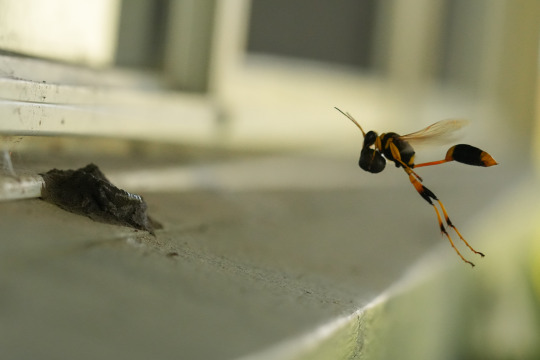

in the photos above, she has arrived with a ball of mud collected from somewhere nearby. this nest isn't for her to live in, but for her young to grow and pupate. in this mass of mud she will craft several individual cells, and provision them all with the paralysed bodies of orb-weaver spiders. each cell will have a single egg laid on the first spider, before being sealed off with more mud.
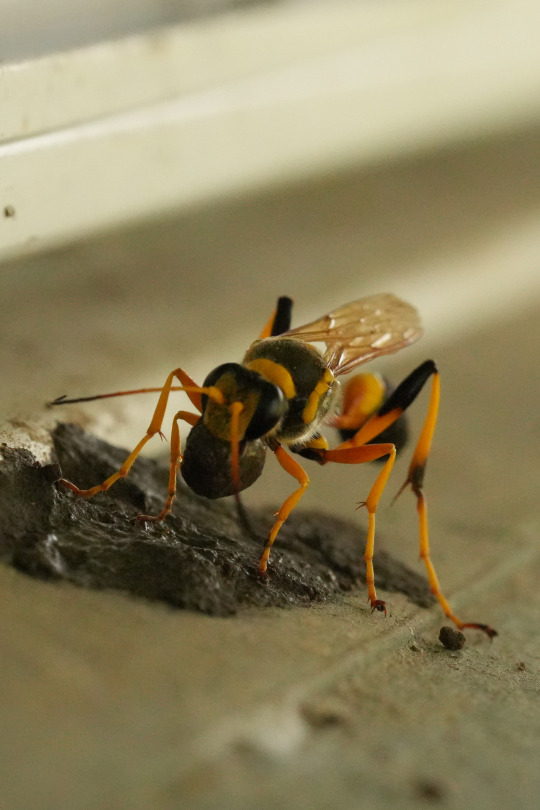
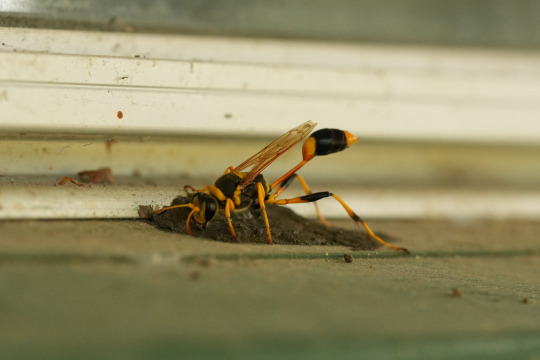
here, she picks the next spot to deposit her ball of mud, using her mandibles to smooth it onto the structure. when the larvae hatch, they will consume all the spiders in their respective cells, before pupating and then emerging as adults wasps.

each time she finished with a layer of mud, she would take a moment to groom her forelegs and antennae, before flying off to repeat the process. these photos were taken earlier in the Summer, and as of posting this, the adult wasps have yet to emerge.
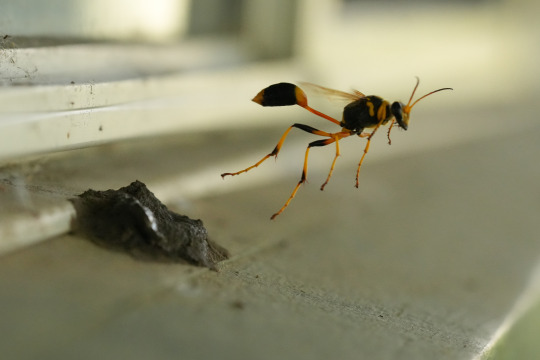
Covered-cell Mud-dauber Wasp, female (Sceliphron laetum).
#ljsbugblog#bugblr#entomology#macro#insects#hymenoptera#aculeata#wasps#sphecidae#thread-waisted wasps#sceliphron#slender mud-dauber wasps#sceliphron laetum#covered-cell mud-dauber wasp
1K notes
·
View notes
Text

The opened egg sac of an orb weaver
By: Cornelia Clarke
From: Natural History Magazine
1936
#trypophobia#spider#arachnid#arthropod#invertebrate#1936#1930s#Cornelia Clarke#Natural History Magazine
53 notes
·
View notes
Note
So, some spider sex facts!
The biggest one is that all things considered, being a male spider kinda sucks for most species. Their lives consist of desperately try to fuck, and then die pretty soon after. (Sometimes the female they just mated with just straight up eats them. It's not super common though. Also the size of male vs female is absurd. The guys are so tiny)
Courting rituals vary between species, so you'll have orb weavers who pluck and tap rhythmically on the webs in an attempt to indicate a. That they're not prey and b. Try to get the female to accept them. If successful the male will pat and stroke the female before sex. Wolf and jumping spiders rely on sight and will wave their pedipalps (the organ male spiders use to initiate sex) in a sort of dance to see if the female is interested. The european nursery spider will actually search out a female, go and catch a fly (or sometimes grab a pebble) wrap it in silk and present it to her so he can have sex while she's eating.
Female spiders actually have spots inside their body for storing sperm, so they actively get to choose which partner gets to fertilize their eggs. Multiple partners common, though some females simply have sex with the same mate repeatedly. Some species will actually make noises while having sex if the male is doing something she doesn't like, and he'll respond to it eagerly since it ups the odds of being chosen as sire to the spiderlings.
Going back to the orb weaver family specifically for a moment, sometimes the silk threads of a web is infused with pheromones from the female that gives wandering males an idea of her health and maturity.
Uh, there are more facts but I'm v tired and need to sleep dkfkdkwjjfj
Thank you so much for your service, my friend 👀📝
130 notes
·
View notes
Note
hi! just outside my apartment door a beautiful almost 2 inch long cross orb weaver made her home over a busy light a handful of months ago!
my family and i have been watching her and we’ve watched her grow, interact with a male, become very plump one day, and then a while later disappear only to come back a few days later significantly skinnier! it feels like we’ve seen her whole life at this point!
our only problem is we’re afraid she won’t last the winter considering it’s already dipping down into the upper 20’s overnight (fahrenheit). is there a way to help her live longer or is she just nearing the end of her life naturally?
picture of our darling queen pepsicola! (you’d be able to clearly see her cross marking if the light wasn’t so close 😕)

She is very beautiful and I love her! It is very normal for orbweavers to only live for a single year - they usually lay their egg sac and then die once it gets too cold. Sometimes, depending on the weather in the area, they can live two years.
It's natural and there's no need to help her! Her children will live on for her :)
85 notes
·
View notes
Text
Uncharismatic Fact of the Day
Wasps can't build webs-- that's why they get spiders to do it for them. Some ectoparasitoid wasps like Reclinervellus nielseni lay their eggs on unsuspecting Cyclosa orb weaver spiders; once hatched, the larva injects its host with a venom that changes the way it weaves its web! The strands used are thicker, tougher, and glow under ultraviolet light, traits thought to prevent superfluous insects from getting caught. Once the web is complete, the wasp larva eats the spider and uses the web as a base for its cocoon.

(Image: A Reclinervellus nielseni larva attatched to its host, Cyclosa argenteoalba, by Keizo Takasuka)
If you like what I do, consider leaving a tip or buying me a ko-fi!
#Reclinervellus nielseni#hymenoptera#Ichneumonidae#ichneumonid wasps#wasps#hymenoptrids#insects#arthropods#uncharismatic facts
91 notes
·
View notes
Text
How to Identify Cross Orbweaver Spiders
Originally posted on my website at https://rebeccalexa.com/how-to-identify-cross-orbweaver-spiders/. Click here to learn more about the How to Identify article series.
Name: Cross orbweaver spider (Araneus diadematus), also known as cross spider, European garden spider, et. al.
Range and typical habitat(s): Native to much of Europe, sporadically found in temperate areas of Asia, introduced to North America, particularly the west coast and northeast United States.
Distinguishing physical characteristics (size, colors, overall shapes, detail shapes) and behaviors: Fall is just around the corner, and if you’re looking for more eco-friendly seasonal decorations, the cross orbweaver is the perfect fit! While these spiders have spent all summer chowing down on insects, by September they’ve gotten big enough to be quite visible on their large orb webs.

A mature female cross orbweaver spider.
Both sexes are a variable combination of orange, yellow, brown, and/or gray, and they all have white cross-shaped markings on the dorsal (upper) side of their rather large, oval-shaped abdomens. The legs are tan to orange with darker brown or gray stripes. Like many other web-weaving spiders, cross orbweavers tend to rest in the center of their web with their head facing down and their legs flexed rather than straight, though the fourth pair in the back may sometimes be extended somewhat. Their legs are covered in fine hairs with a fuzzy appearance. They are also known to perch on nearby leaves and twigs.
Like other members of the family Araneidae, the orb-weavers, these spiders have four pairs of eyes. Females are larger than males, reaching up to 1″ long in exceptional individuals, while males usually top out at 1/2″ or less. A close examination shows that males can also be distinguished by large pedipalps with swollen ends. These are little appendages nestled between the chelicerae (jaws) and the first pair of legs. Males use the pedipalps in mating displays, and to also pass sperm to the female. A courting male needs to be careful, as females will engage in cannibalism.
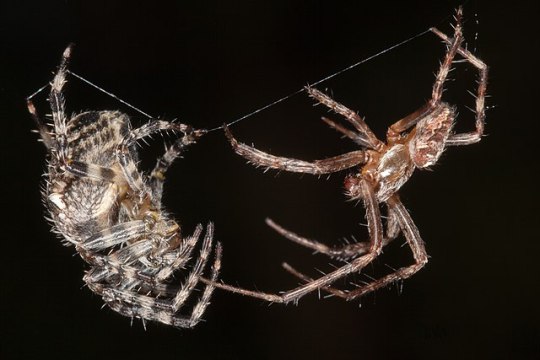
A male cross orbweaver (right) carefully approaches a female (left) with the intent to mate.
The eggs laid by females the previous fall hatch in spring, releasing several dozen (or more!) tiny yellow spiderlings into the world. While they make webs as soon as they find a good location, these young spiders often end up as prey for other animals themselves. Cross orbweavers generally live no more than a year, though females die shortly after laying their eggs, and males are often eaten by their mates.
The web is made of a series of overlapping threads of silk like the spokes in a wheel, with a spiraling orb starting at the center and working its way outward. A cross orbweaver’s web may be quite large, and the central orb may at times exceed two feet in diameter. They are not picky about where they set up shop, and are often found near homes and other buildings, where they are quite adept at catching flying insects that blunder into the web. If threatened, these spiders shake their web vigorously, and are not prone to bite unless handled roughly. They may dry bite in self-defense, choosing not to use venom. Their venom is not considered dangerous to humans.

Other organisms it could be confused with and how to tell the difference: There are several other Araneus species that look quite similar to the cross orbweaver. Of these, the most similar is the four-spot orbweaver (Araneus quadratus) has less variegated orange, green, or brown abdomen with four small white spots on it rather than a cross, though they have similarly striped legs. It is found only in Europe.
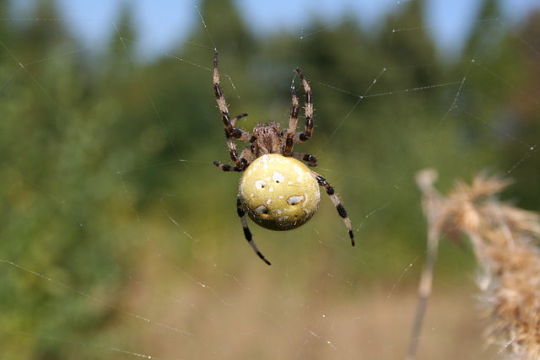
Araneus quadratus
The cat-faced spider (Araneus gemmoides), also known as the jewel orbweaver, is of similar size and color variation to the cross orbweaver. However, its abdomen has two pronounced points on top that look rather like a cat’s ears. Araneus gemma (not pictured) is also sometimes called the cat-faced spider or the gem-shaped spider, and it has a similarly shaped abdomen but tends to be paler in color. Both of these species are primarily found in the western half of temperate North America.

Araneus gemmoides. By Trucmuche04, CCA-SA-3.0
Anything else worth mentioning? Because the cross orbweaver is not native to North America, it competes with native spiders for food. This is especially concerning as insect populations have plummeted in recent decades due to pesticide use and habitat loss. It is often found in urban areas and other places with lots of human habitation, and is considered an invasive species in the Bay Area. They are considered harmless to humans.
Further Reading:
Cross Orbweaver Spider
Cross Orbweaver
Cross Orbweaver (Araneus diadematus)
Spiderspotter: Cross Orbweaver
Did you enjoy this post? Consider taking one of my online foraging and natural history classes or hiring me for a guided nature tour, checking out my other articles, or picking up a paperback or ebook I’ve written! You can even buy me a coffee here!
#spider#spiders#cw spiders#spider tw#cross orbweaver#orb weaver#arachnids#arthropods#invertebrates#bugs#wildlife#animals#wild animals#nature#nature identification#invasive species#biodiversity#science#scicom
52 notes
·
View notes
Text
miscellaneous bugs volume 3
all bugs found in new zealand.

brown evening moth. endemic to new zealand.
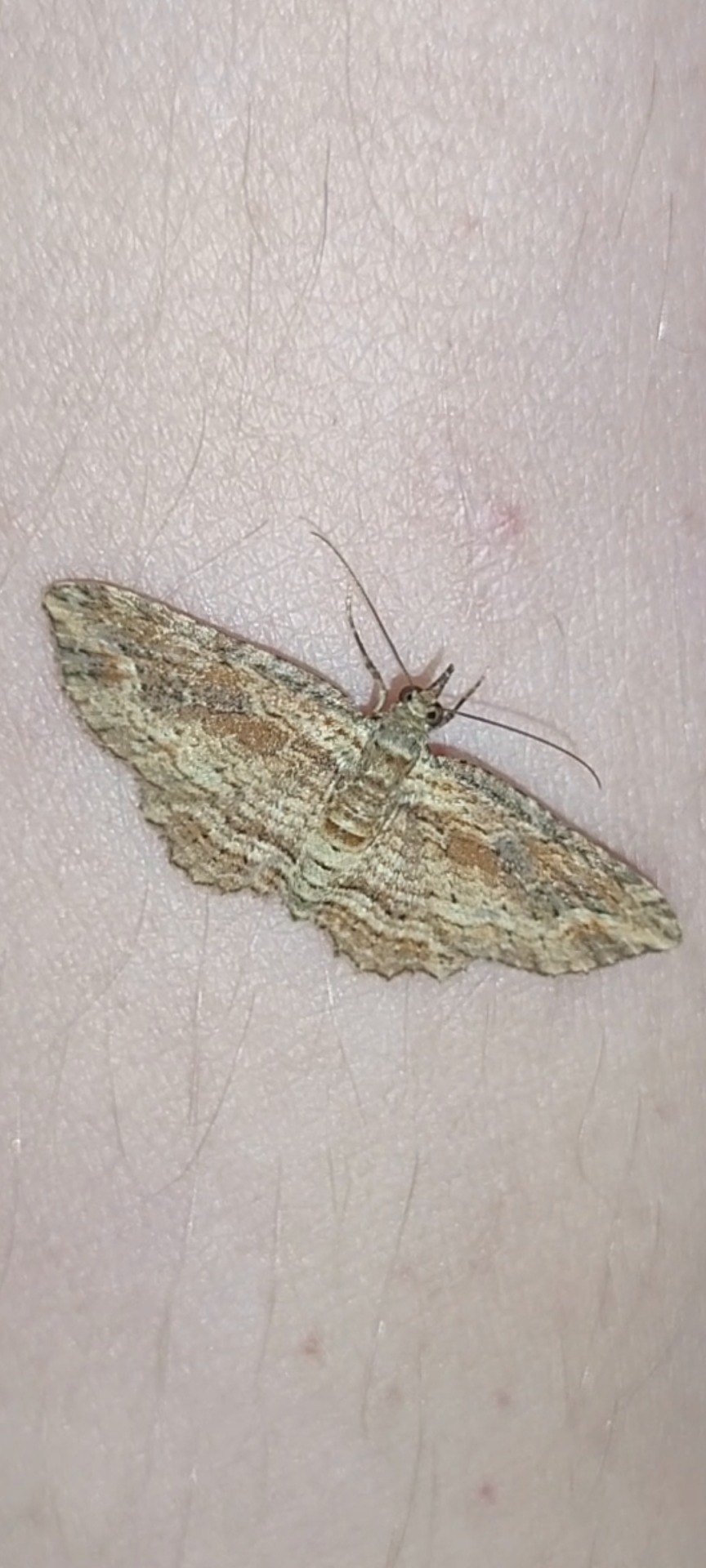

other unknown moth.
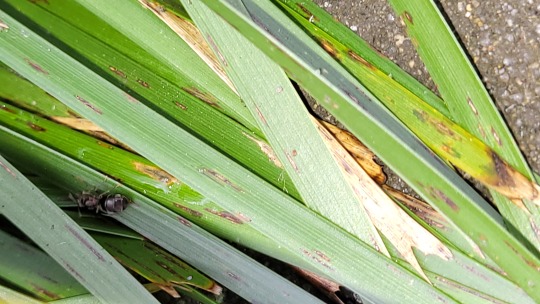

queen ants (iridomyrmex undescribed) after a mating flight, searching for a spot to begin their colony.
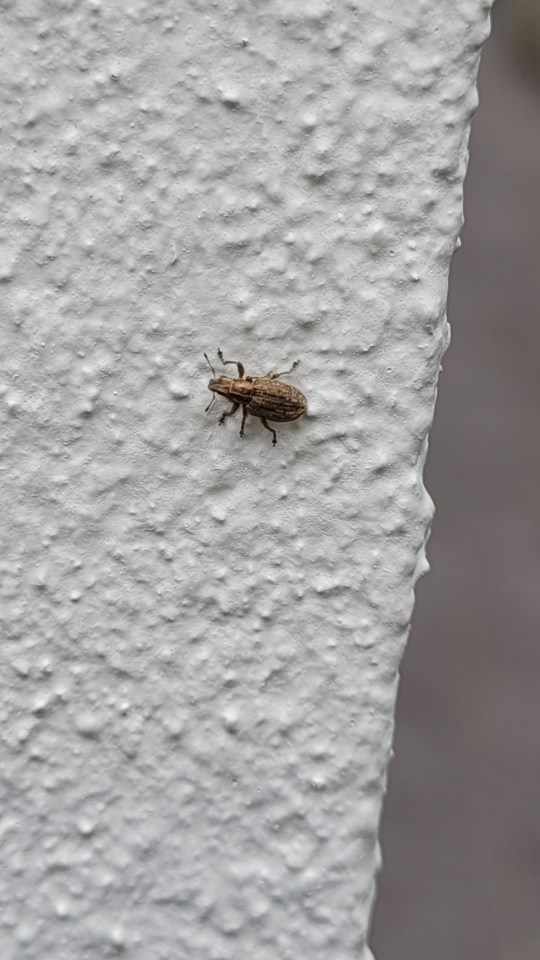
we've got boots, but bo snoots... a snootless weevil.

trite planiceps, the black-headed jumping spider.

l'il baby looking parasitiod wasp.
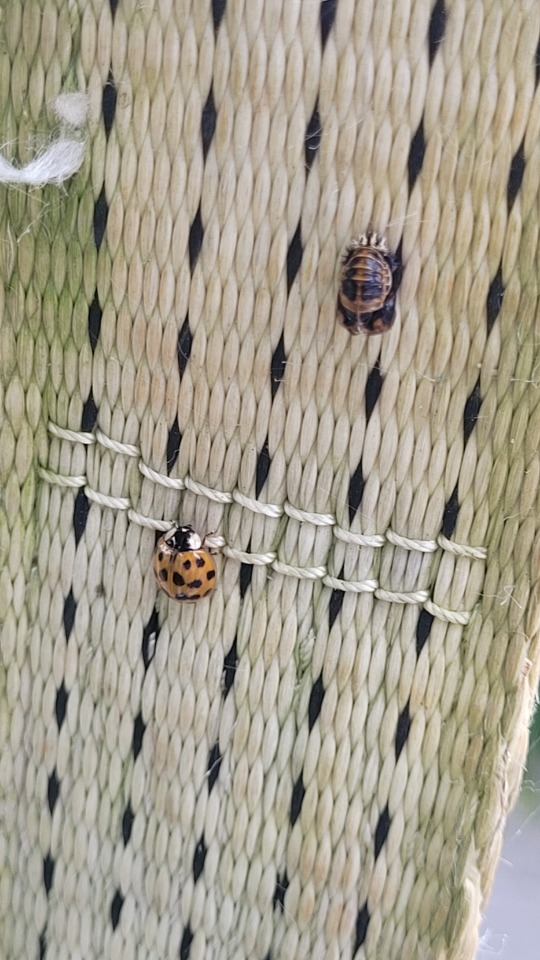
asian lady beetle next to its molt.
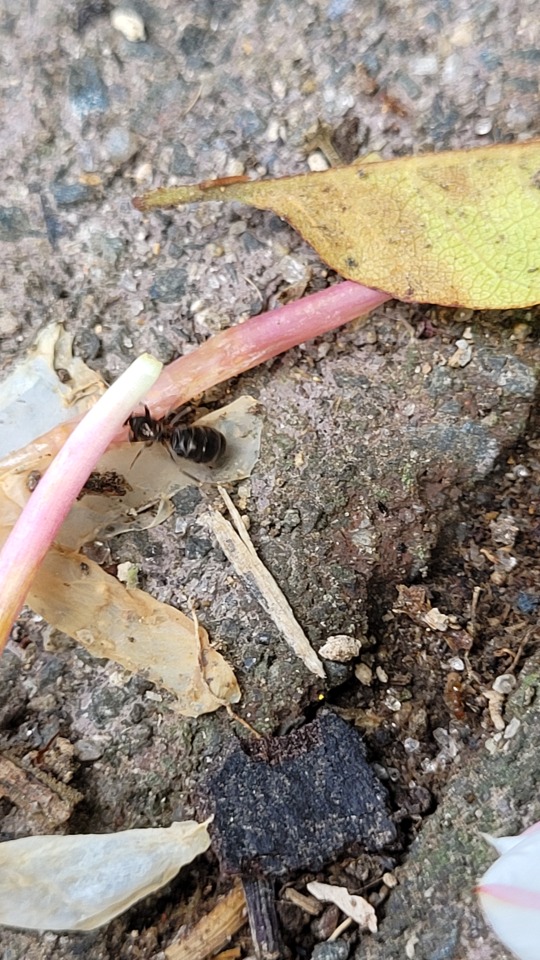
another queen ant, cuz why not? see if you can spot the southern ant in this photo.

the ants are farming this mealybug on my line tree.

here are some funky orb weaver eggs.

european praying mantis nymph.
MINOR YUCK FACTOR AHEAD...

snail poopin.

the ants have found this scarab beetle quickly.
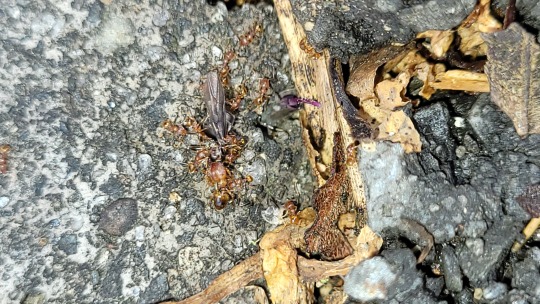
see the major tearing apart this queen with help from the workers.
thats all.
#entomology#bugblr#insects#bugs#myrmecology#ants#beetles#moths#insect#bug#beetle#arachnid#jumping spider
25 notes
·
View notes
Note
Hell yeah!! I've been told that spiders make little blobs and fill them with eggs as a nest kind of thing. Are there any that make like... Burrows or something? Or egg blobs that don't look like just blobs? Or some that make really funky webs? I'm arachnophobic so I don't have the balls to look it up myself :( Love looking at spider webs though. Some of the places they get built are absurd it's really interesting! And pretty when it rains!
And how are Petunia and Toe? They good?
Oh!!
absolutely!
Yeah so the blobs you mentioned are the egg sacs, I could be wrong but I believe all spiders form egg sacs of some kind, either tightly wrapped and bundled to protect their eggs, or just loosely to keep the eggs together.
Now i'm gonna go on a bit of an egg sac tangent here.
This example is specifically with web-dwelling spiders like widows or other orb weavers for example, but to make their sacs they start out with making a disc-shaped section of web and then release a fluid-like sac that they release all their eggs into one by one!
Once the sac is full, they can wrap it up in many layers of a protective silk to keep the eggs insulated and away from the external elements.
A spider can lay hundreds of eggs at a time and with spiders like widows they may lay multiple sacs filled with eggs!
In this example of widow spiders they usually keep the sacs in their web to guard them, but other species of spiders may just leave the sac somewhere obscured or hidden so the babies can hatch and grow a bit before leaving to live their own lives.
But this is far from the only way!
My favourite are wolf spider mothers! These are land-dwelling spiders that, as you asked, do create burrows for themselves! Quite a lot of the land-dwelling spiders do in various ways! These wolf spiders will actually stay with their egg sacs and will adamantly guard it if a predator approaches. when the babies hatch, they will climb onto the mother's back as she continues to protect them! Such a sweet mother! There are many other arachnids that have a similar situation such as scorpions, whip-scorpions, and vinegaroons! (to name a few)
Now! another popular set of burrowing land-spiders are tarantulas! and they will lay their egg sacs in their burrow where the babies will be safe to hatch!
which, sidenote i gotta say those little guys are just the most adorable things ever ToT one of my favorite types of baby spider for sure! So fuzzy! And when they just barely hatch they are in an "eggs with legs" stage that is just so precious. Literally what will later become their abdomen is just an orb like the egg they just hatched out of, but they now have a litte teeny underdeveloped cephalothorax and set of legs along with it. they just sorta barely wiggle them it's so adorable (imo).
However they need to be careful, a lot of baby spiders do.. as once they hatch and stay a bit too long around the mother as they grow, she may mistake them for a meal sometimes and many do sadly get eaten if they are not careful.
In fact! most tarantula owners/breeders will remove the egg sac when their tarantula has one as it is also a possibility for the tarantula to eat their own egg-sac!
Not sure of the reason why, but it could be to re-gain nutrients (in the most counter-productive way lol) or for some other unknown reason. I've had chickens do the same thing with their eggs :(
Anyway!
But yea! there are tons of land-dwelling spiders, like funnel weavers, tarantulas, trapdoor spiders, velvet spiders, and many more that make burrows for themselves! either by digging one, or forming one solely out of their webbing, or usually a mix of both!
oh! and for jumping spiders! they also will protect their eggs and stay with their babies to protect them until they are old enough to leave on their own!
Usually the mothers won't eat around this time which can be concerning from the perspective of a spider ower haha
jumping spiders don't really live in webs or burrows, but they make little silk sacs and hammocks or 'hides' for themselves under leaves or in crevices somewhere that it's not too easy to spot them! It's super cool to see really! and if you feel the silk, it's super soft! Like I would genuinely think it to be so cool to be tiny and lay down in the silk because of how soft it is! My jumping spiders make these curtain-like sheets of silk inside their hides (in my spiders' case, acorn shells or little hollow round silk structures for them to feel safe and hidden) and it just looks so cool! Hold on I could probably show a picture! (no spiders in sight)


they made these specifically while they were molting, to feel safe and protected while they are exposed and vulnerable! but I have found abandoned sacs like this before and gosh they are so extremely soft! Looks so cozy!
ANYWAY! XD
Petunia, my widow, and Toe, one of my jumpers, are doing great!
I would add a photo of them but since you mentioned being arachnophobic I best not haha! /lh
They are doing well though! and my other spiders are too! Muffin recently molted again, so did Toe, but neither of them ejected their old exoskeletons from their hides so I can't collect their little hats :(
but that's ok!
I am just glad that they both molted safely!
I finally named my Habronattus tarsalis as well, (i got him a while back!) His name is Wilbur!
On a bit of a sad note, I was originally going to make a post about it but I really didn't wanna bum anybody out.. Persphone, my female barn funnel weaver, passed away about two weeks ago now...
Her passing hurt me greatly.. especially since I was not even sure of what might have caused it.. But Whatever happened.. I just hope she's in a better place now.
Brometheus, my male barn funnel weaver, on the other had is still doing great! Better than ever I think! He seems super healthy right now and I am so glad!
Fred, my male black widow is also doing well!
But yeah! I currently have 6 spiders! And I love them all deeply! Petunia, my female black widow, was my first one and she resides in her enclosure right next to my bed haha 😁
(my family thinks I'm insane💀)
OH MY GOSH I JUST NOTICED HOW LONG THIS POST IS
it is currently 6am as I am writing this and I haven't slept yet, so my apologies on if there are any typos or errors! (I have a tendency to just sorta spew my thoughts out all at once with very minor editing 💀)
But I hope this helped a bit! And so sorry it's so long and convoluted too ToT
#long text post#ask response#random rambles#spiders#no photos of spiders- just talking about them!#also i agree that webs are such cool and beautiful structures! coming in all sorts of shapes- patterns- and sizes! it's super cool!#I just love spiders man ToT
18 notes
·
View notes
Note
Top 5 spiders?
1. Jumping spiders (any species). I mean… look at them. They’re like a cartoon character
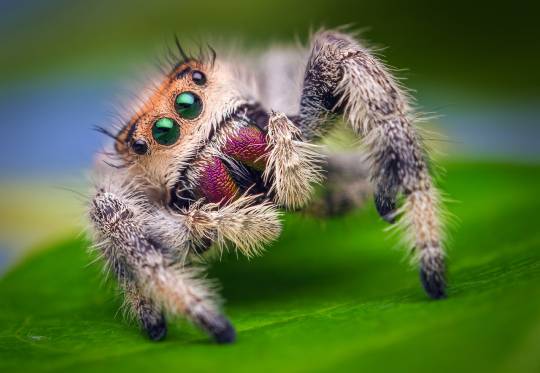
2. Colombian lesser black tarantulas. They keep frogs as pets to guard their eggs!
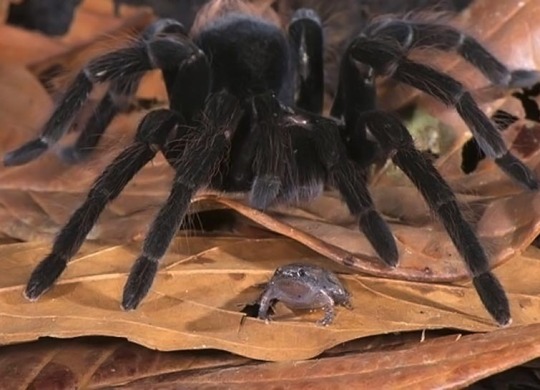
3. Mirror spider. They look like some glass sculpture but they’re real! They’re out there living their life rn!

4. Long-horned orb weaver. Um?

5. Barn spider. Something about the way they’re shaped squicks me out a little (I can’t figure out why exactly) but my mom befriended one last summer so I have a soft spot for them anyway.

145 notes
·
View notes
Text

Wasp Spider (Argiope bruennichi)
Family: Orbweaver Family (Araneidae)
IUCN Conservation Status: Unassessed
Named for its striking yellow-and-black striped abdomen which is thought to mimic the warning stripes seen in many wasp species in order to deter predators, the Wasp Spider can be found across much of northern Africa, Europe and temperate Asia, where it primarily inhabits open habitats (particularly grasslands.) Like most orb-weavers, members of this species build broad, thin webs in clearings among vegetation and feed on flying insects that become snared within it; often remaining concealed around the edges of their web in order to make their trap less obvious, Wasp Spiders respond to the vibrations caused by ensnared prey struggling against the silk by springing forward, wrapping their prey in a tough silk case to prevent its escape and then injecting both venom and digestive enzymes through their flexible fangs - their prey is then digested externally, and the resulting protein-rich remains are ingested by the spider. Female Wasp Spiders (such as the individual pictured above) are drastically larger than males (growing to be around 15mm/0.6 inches long, while males rarely exceed 4.5mm/0.2 inches in length,) and like many female spiders they do not seem to distinguish between males of their own species and any other similarly-sized arthropod, as cannibalism of males by females is commonly observed. During the summer mating season, males approach females with extreme caution and attempt to carefully deposit a packet of sperm and nutrients into a reproductive orifice on the female's underside without being noticed using a pair of elongated limb-like structures called pedipalps that extend from near their mouths; if a male succeeds in mating the pedipalp he used to transfer his gametes to his mate will break off and "plug" the female's orifice for the rest of the mating season (preventing other males from introducing gametes into the female's body that would compete with his own,) although it should be noted that even after successful mating the majority of males are still caught and eaten. After mating female Wasp Spiders lay large clutches of eggs which they wrap in a tough protective sac of silk and attach to tall grasses; the adults, which are unable to endure cold temperatures, pass away in the winter, with their young emerging in the following spring.
--------------------------------------------------------------------------
Image Source: Here
#Wasp spider#spider#spiders#arthropod#arthropods#zoology#biology#entomology#animal#animals#wildlife#African wildlife#European wildlife#Asian Wildlife#tw spider#tw spiders#cw spider#cw spiders#cw arachnophobia#tw arachnophobia#invertebrate#invertebrates#arachnid#arachnids
27 notes
·
View notes
Text
THE SPIDER UPDATE
Finding orb-weavers just seems like Easy Mode now, so of course my stupid brain requires a challenge. We're going fully webless babes!
It's been a tense, odd week of staring at a lot of stucco walls in the hot sun with very limited success lol CLICK THROUGH FOR PHOTOS
Here are some wall friends, not officially identified but I think maybe Selenops genus? (They camouflage well, and they also tend to flatten themselves to walls or right into little dents or holes, so I still haven't managed any truly clear photos, and no sign of the the eyes, which is usually how I’d ID for sure. Hence the staring at walls all week.)
EDIT: Figured these guys out eventually! Wall spiders (Oecobiidae), probably Oecobius genus.


This one I think is a running crab spider (Philodromus genus, different from the crab spider I found in the rose).

She’s got her eggs! And when I found her the next day, she also had, uhhhhh….

Well. I think that’s one of the little Selenops guys she’s got pinned under her jaws lol oh well! Circle of life!
I do not know who this lady is. False black / brown widow perhaps?
EDIT: Eventually got this ID from iNaturalist: GROUND SAC SPIDER (Trachelidae): Genus Trachelas
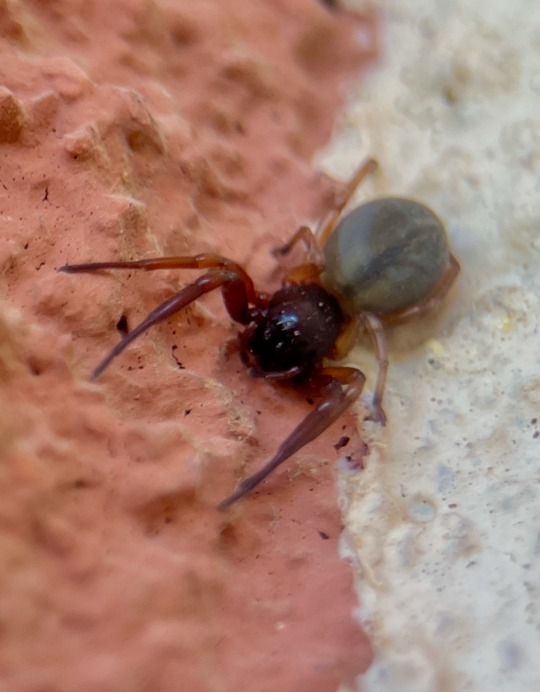
And not to play favorites but saved the best for last:



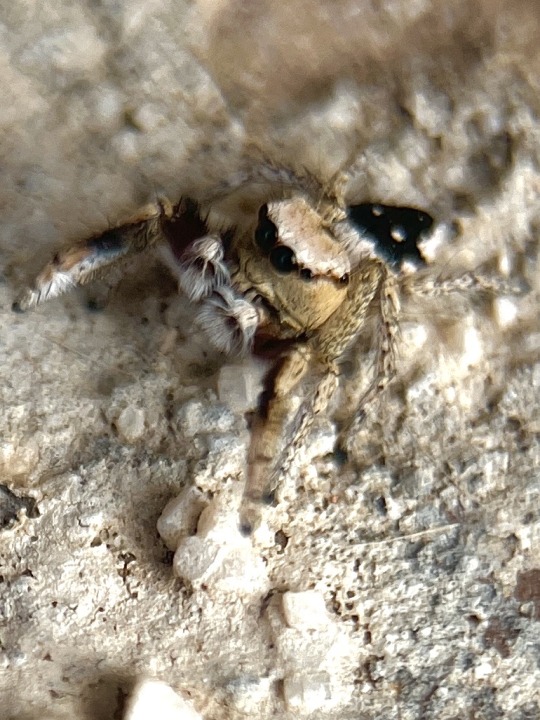

(Oh and because I truly didn't grasp the size of these things until I started looking for them in person, here is the little gray one next to my index finger)

I need you to fully understand how impossible it is that I found any of these lol my passion is overcoming my nearsightedness and severe lack of depth perception
#please PLEASE look at the absolute wagon of an abdomen on that one jumper lol#what a queen#spiders#eight-legged friends
21 notes
·
View notes
Text
Fuck, does he love them.
“James …”
He tears his gaze away from Regulus and peers up at Lily through his eyelashes from where his head is resting on her lap, one eyebrow raised in question. Forehead wrinkled a little in concern at her careful tone.
“Don’t freak out now, but-”
“What do you mean don’t freak out now?!”
“Calm down, mon beau, she won’t break up at picnic ..”
“Break up?! I wasn’t even thinking about that possibility!”
Lily glares at Regulus as if to say: is this your way of helping? But he only shrugs, huffing something about Sirius’ dramatics rubbing off on James.
“I’m not breaking up. It’s just …”
“What is it, love?” James encourages, immediately more relaxed at that.
“There is a spider in your hair-”
“WHAT?!" No longer relaxed.
“BUT I will take it out! Stop moving so much, I’m trying!”
He dutifully drops his arms, squeezing his eyes shut while she comps through his curls, hopefully getting rid of it, before it lays its eggs in there. Or whatever it is they do …
“There we go, all done” Lily eventually croons, the way doctors talk to children after giving them an injection.
James carefully opens his eyes again, blinking away the spots, to find her smiling at what probably is the spider crawling around the palm of her hand.
He scrunches his nose in disdain, moving from where he was comfortably lying to sit a few metres away.
This earns him an overdramatic huff from Regulus who is moving closer to Lily, peering at the monster in her hand.
“You insist on watching the spider-man movies every couple of months, but get scared because of this little lad?”
Regulus leans in closer, to get a better look at it.
“Do you know what kind it is?”
“I reckon it must be an orb weaver, based on …”
James drowns their conversation out, but he does continue staring at them, a smile plastered on his face.
Fuck, does he love them.
(Words: 333)
Pssst, this is based on this!
#loonsmoons#short lil drabble#i am a genius.#(or so i've decided)#“Have another idea for a WIP? Just post a lil drabble instead!”#*in a salesperson voice*#no because i wanted to write some jegulily#and i was feeling summer vibes today#so naturally i had a new fic idea#but NO. let's turn it into a short lil drabble instead :)#jegulily#james x regulus x lily#james potter x regulus black x lily evans#james potter#regulus black#lily evans
49 notes
·
View notes